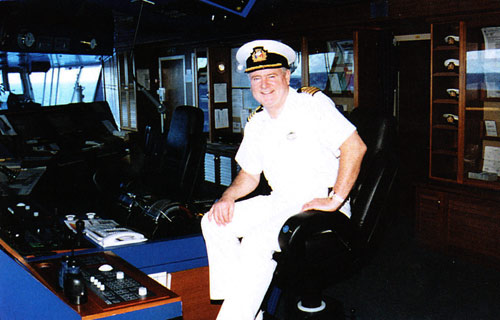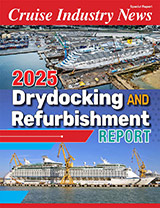 “We have the technology to take this ship into practically any port we choose, despite her size,” said Captain Bernard Warner aboard the 109,000-ton Golden Princess. “She is extremely maneuverable with 9,000-horsepower bow thrusters and 7,000-horsepower stern thrusters. We can hold her up against a 30-knot wind even though the side of the ship measures 114,000 square feet – equal to 2.7 acres.”
“We have the technology to take this ship into practically any port we choose, despite her size,” said Captain Bernard Warner aboard the 109,000-ton Golden Princess. “She is extremely maneuverable with 9,000-horsepower bow thrusters and 7,000-horsepower stern thrusters. We can hold her up against a 30-knot wind even though the side of the ship measures 114,000 square feet – equal to 2.7 acres.”
Warner explained that the tunnel thrusters measure eight feet in diameter and have controllable pitch propellers, while the ship’s two main propellers measure 18.5 feet in diameter, and the two rudders are 24 by 12 feet and can be operated independently of each other. Using five out of six engines, the Golden Princess was doing 20.5 knots as we were talking. “We take the most economical speed from point A to B,” Warner noted, adding that “it is best to run the engines at full speed so they don’t clog up. We get about 60 feet to a U.S. gallon of fuel and burn about 55,000 gallons a day.”
When the Golden Princess relocates to Barcelona this spring, Warner expects her to have three days worth of fuel in reserve.
The smallest port, he has ever taken her into is Piraeus.
If he has to do an emergency stop, the ship will stop – with engines full astern – in just under five-and-a-half minutes. During sea trials, the Golden Princess was also able to make a complete turn within a 700 meter radius or two-and-a-half ship lengths.
Despite her size, the draft is only 28 feet.
Warner’s top priority is the safety and welfare of his passengers and crew. The challenges are the same as if he were mayor of a big city, he said, noting that the key is to have good department heads that take care of their areas of the ship.
The captain does a walk-through of the ship every morning from 7:30 to 9:00, seeing all the senior department heads as well as visiting the galley. “I am there for all the crew,” Warner added. “They can ask me questions if they want to. The crew is very important on a big ship like this.”
There are always four people on the bridge of the Golden Princess, including a look-out, who are also checking each other.
“I encourage my officers to take visual bearings as well as use computers,” Warner continued. “We still have paper charts – I insist – in addition to computer charts. We plot the course both on the computer and the paper charts.”
The Golden Princess has five radar sets on the bridge – picking up everything within a 96-mile radius.
Warner started his apprenticeship with P&O on a 7,000-ton cargo ship back in 1966 sailing to the Far East. His first passenger ship was the Oriana in 1969, and after P&O acquired Princess Cruises (1974) Warner moved to the Island Princess in 1976- his first cruise ship – as second officer.
Joking, Warner said at 20,000 tons and with 640 passengers, the Island Princess would fit in the Horizon Court restaurant aboard the Golden Princess.
As he moved up the career ladder, Warner has been captain on the Island, Pacific, Royal, Dawn, Grand and Golden Princesses and was moving to the new Diamond Princess in March.
“Apart from the turbines, I believe the Diamond is very similar to the Golden Princess,” Warner said, “apart from the skywalk not being separate, but incorporated into the design.”
Warner, who hails from Yorkshire in the North of England and now lives in Warwick, is married, and he and his wife Tina have two sons, Charlie, eight, and Tom, 13
.
They join him during school holidays. He met his wife aboard the Royal Princess and first “spied” her, as he put it, as she walked on the pier towards the ship in Southampton carrying her bags. It turned out she was the manager of the spa. After learning that, Warner said he went for a lot of hair cuts to get to know her.
“I think anybody who wants to go to sea can have a great future,” Warner said. He was attracted as a boy and said he always liked the sea. “The only drawback is that you do not make a lot of money when you start. I earned 17 pounds sterling a month when I started, but that did not matter to me in those days.”
Warner made captain at 45. Assuming the responsibility for up to 3,100 passengers, more than 1,000 crewmembers, and a $464 million ship comes with training, according to Warner, who said he has been brought up to accept responsibility and has learned to live with it.
“I am always aware of the dangers around us,” he said. “I respect the ocean and the weather.
“But with the weather today, you have plenty of warning. We will not go near any storms. In the old days, however, you did not have much of an idea of what the weather would be before it arrived.
“If we were ever to get stuck in a hurricane, this ship can withstand anything. But the passengers may not be comfortable.” He recalled one crossing where he had hit 40 to 50 foot waves for three days.
Another memorable voyage was with the Baywatch crew shooting a segment aboard ship in Alaska.
Warner described the Golden Princess as a resort at sea, offering passengers lots of choices in dining and entertainment. She is 184 feet from the waterline to the top of the mast, 220 feet from the keel to the top, and 118 feet wide at the waterline.
Captain Warner took her out from the yard (Fincantieri) and has served on the Golden Princess for the past two-and-a-half years. He also has a license issued by Bermuda enabling him to marry passengers, and he has performed 380 wedding ceremonies in those 30 months.
But a bigger ship creates bigger needs to find ways to communicate with the passengers, according to Warner, who said he conducts a question-and-answer session during each cruise. A popular question is: Who is driving the ship while he is talking to passengers? “I usually answer that I have absolutely no idea. That generally puts everybody at ease,” Captain Warner smiled. – Oivind Mathisen
Excerpt from the Cruise Industry News Quarterly Magazine: Spring 2004



